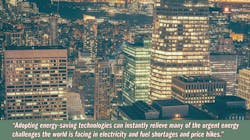With COP26 in action, Signify CEO urges doubling the pace of building renovations
With the COP26 global climate conference in full swing in Glasgow, Signify CEO Eric Rondolat this week took the opportunity to remind the world that Internet-connected LED lighting can help slash carbon emissions.
While general awareness of LED energy efficiency has been long established, what was notable about Rondolat’s message was the emphasis on connected lighting — which enhances efficiency gains by adding the intelligence of smart controls and usage analysis.
In a broad general scenario, Signify estimated that a switchover to connected LED lighting in the professional market could reduce CO2 emissions equivalent to the amount that 25 billion trees can absorb in a year. The electricity savings would be equivalent to the annual consumption of 494 million households, the company said.
“Interventions like the switch to renewable energy take time to yield results,” Rondolat said. “Adopting energy-saving technologies can instantly relieve many of the urgent energy challenges the world is facing in electricity and fuel shortages and price hikes. We can act today by accelerating the switch to energy-efficient lighting, by doubling the rate of building renovations per year, and by mobilizing consumers to make their own significant impact in the Race to Zero.”
The Race to Zero is a United Nations campaign to reduce carbon emissions to zero by 2050 at the latest. COP26 is the popular name for the 2021 United Nations Climate Change Conference; it is the 26th meeting of the Conference of the Parties (COP) to the United Nations Framework Convention on Climate Change, held first in Rio de Janeiro in 1992.
Rondolat’s call for accelerating the switch, and for picking up the pace of building renovation, perhaps belies what the Signify boss has in the past described as a long education process in convincing the market of the benefits of connected lighting. Uptake by commercial users has been slower than the industry — not just Signify — had hoped for, although earlier this week Rondolat expressed confidence that users are now tuned in.
Still, the rate of conversion has been sluggish. Last August, Rondolat criticized what he called the “glacial pace” of the move away from conventional lighting in the commercial market. Earlier this week, Swedish LED lighting company Fagerhult Group’s CEO Bodil Sonesson noted that “the share of installed LED lighting is only about 30% in Europe.” Speaking during her company’s third-quarter financial presentation, she added that “connectivity gives an additional 70% efficiency.”
The fluorescent lighting that remains a strong part of the mix also comes with environmentally damaging mercury. Campaigners are pushing to eliminate fluorescents for that reason. They have called on Rondolat to join a movement that would end a mercury exemption for fluorescent. In an international treaty known as the Minamata Convention on Mercury, 135 countries agreed in 2013 to end the use of mercury in products and processes but granted an exemption to fluorescent lighting on the grounds that there were no cost-effective alternatives. Times have changed. Roger Baros, who leads a pan-African contingent of Minamata, has proposed an amendment that would add fluorescent lighting to the ban. In an open letter to Rondolat via LEDs Magazine last month, he encouraged the Signify boss to back the cause.
LEDs is unaware of Rondolat yet signing up. We have sent the company an email asking what their intentions might be regarding the amendment.
Minamata, named for the Japanese city where the convention first met, is a UN initiative.
Signify has taken many measures aimed at environmental sustainability, including eliminating plastic from consumer packaging, tapping renewable energy electricity sources, and using 3-D printing for some of its luminaires.
Rondolat made his connected lighting comments in a press release. He was not in attendance at COP26, where Signify is represented by, among others, Harry Verhaar, head of global public and government affairs, and by Stephen Rouatt, CEO for UK and Ireland.
“Driving energy efficiency improvements will reduce emissions and at the same time save businesses and consumers money, and create jobs,” Rondolat said.
MARK HALPER is a contributing editor for LEDs Magazine, and an energy, technology, and business journalist ([email protected]).
For up-to-the-minute LED and SSL updates, why not follow us on Twitter? You’ll find curated content and commentary, as well as information on industry events, webcasts, and surveys on our LinkedIn Company Page and our Facebook page.

Mark Halper | Contributing Editor, LEDs Magazine, and Business/Energy/Technology Journalist
Mark Halper is a freelance business, technology, and science journalist who covers everything from media moguls to subatomic particles. Halper has written from locations around the world for TIME Magazine, Fortune, Forbes, the New York Times, the Financial Times, the Guardian, CBS, Wired, and many others. A US citizen living in Britain, he cut his journalism teeth cutting and pasting copy for an English-language daily newspaper in Mexico City. Halper has a BA in history from Cornell University.





